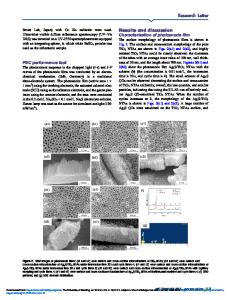Dependence of photoelectrochemical performance on TiO 2 nanorod length
- PDF / 6,519,426 Bytes
- 6 Pages / 612 x 792 pts (letter) Page_size
- 3 Downloads / 316 Views
Dependence of photoelectrochemical performance on TiO2 nanorod length Jen-Chun Chou, Min-Han Yang and Jon-Yiew Gan Department of Materials Science and Engineering, National Tsing Hua University, Hsinchu, Taiwan Abstract TiO2 is one of the most promising photoanodes for solar-hydrogen conversion by water splitting. Recently, hydrothermally synthetic rutile TiO2 nanorods (NRs) show outstanding photoelectrochemical (PEC) performance in water splitting because of its large surface area, fast carrier transport, and short diffusion length. However, light absorption and carrier transport conflict. Few have investigated the dependence of PEC performance on NR length. This study examines how different TiO2 NR lengths grown on an FTO substrate affects their PEC performance when splitting water. The results show that the optimal absorption length of rutile TiO2 NRs is 3.75 μm. However, under simulated solar illumination (AM1.5 G), the maximum PEC efficiency of these TiO2 NRs is 0.33% at a length of 500 nm. This suggests that carrier transport is the most important variable for improving PEC efficiency. Introduction Photoelectrochemical (PEC) water splitting can convert solar energy directly into hydrogen, which is a storable, clean fuel [1-3]. Of all potential PEC materials, TiO2 is the most widely investigated semiconductor because of its excellent chemical stability, cheap and nontoxic, and suitable band edge position to enable oxidation/reduction of water [4, 5]. Recently, hydrothermally synthesized rutile TiO2 NRs have become a popular research topic for PEC water splitting because of their large surface area and fast carrier transport [6-8]. This structure has achieved the best conversion efficiency (1.63%, AM1.5 G illumination) for rutile TiO2. However, a gap exists between the reported conversion efficiency and the theoretical calculation efficiency of 2.25% at 100 mW/cm2 AM1.5 G illumination [9]. The reason for this gap is unclear. This study created rutile TiO2 NRs of different lengths using hydrothermal synthesis. Optical analysis shows that the optimal absorption length of rutile TiO2 NRs is 3.75 μm. However, under simulated solar illumination (AM1.5 G), the maximum PEC efficiency of these TiO2 NRs is 0.33% at a length of 500 nm. This suggests that electron transport is the most important variable for improving PEC efficiency. Experiment details
The precursor solution consisted of 15 ml concentrated hydrochloric acid (37%, Aldrich) and 15 ml of de-ionized (DI) water which were mixed and added to 0.5 ml titanium isopropoxide (TTIP, 98%, Aldrich). The fluorine-doped tin oxide (FTO) coated glass (10 ohm per square) was cleaned by sonication for 15 min first in acetone, ethanol, DI water, and then IPA. The FTO was placed in a Teflon reactor and the precursor solution was added. The Teflon reactor was loaded in the autoclave and placed in an oven. Conditions were maintained at 180°C for 1 to 6 h. After the solvothermal reaction, samples were taken out, washed with DI water, and dried in ambient air. Samples were then s
Data Loading...










